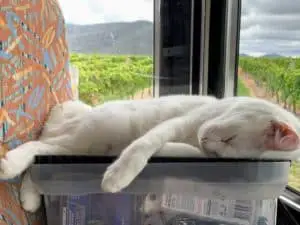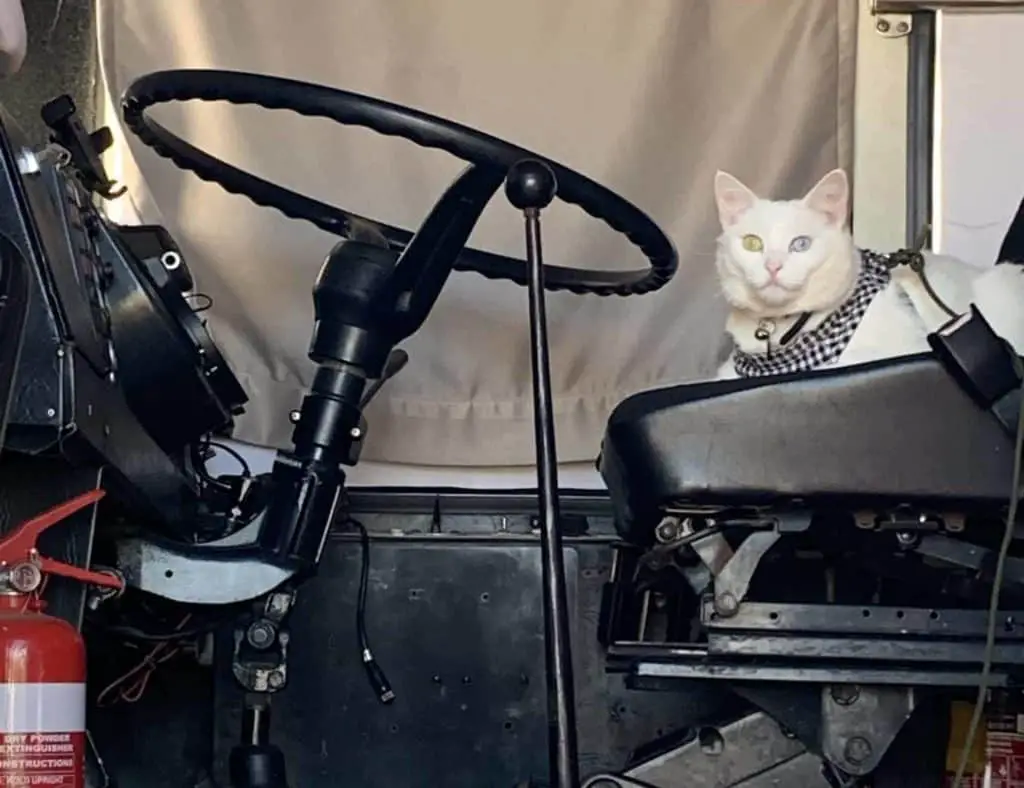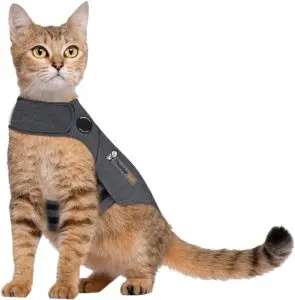Taking to the freedom of the road is fraught with many challenging decisions; managing cat travel is a big one. If you have a natural adventure cat who is already used to walking on a leash and traveling in a car, you still need to plan, but you are ahead of the game. If your kitty is not inclined to adventure, don’t despair. While we understand that not all cats can adapt to travel, we are confident that with preparation and patience, most can.
How to travel with a cat – a management issue
When you travel with a cat, you have to manage the process carefully – of course, “manage” and “cat” are contradictory terms. It can be done.
Whether you have a kitten (lucky you) or a mature cat (we started with a 5-year-old grumpy cat), the process is the same. The latter requires more patience. As with most challenges, the most difficult part is figuring out where to begin. But really, the secret to getting ahead is getting started (thanks to Mark Twain for these sage words).
On the first read, these considerations may be overwhelming. But this is an adventure. Accept that it may be stressful at times (because it will) and that it may not be the perfect scenario in the beginning.
If your cat is anything like ours, then he or she is part of the family. The anxiety we went through trying to figure out what would be best for the cat before deciding to take her with us was far worse than the stress of hitting the road. She has surprised us with her adaptability and a newfound zest for adventure. It has been a learning process for both cats and owners.
Just for the record darling, not all positive change feels positive at the beginning
S.C Lourie
1. Training
Start Early
In considering how to travel with a cat you need to get ahead of the game before the game begins. When we say start early, we don’t mean age, we mean now. It takes time to train your cat, yourself, and your family. The more time you have, the better the outcome for all. Start early, really early, like today.
Understand Your Cat
When we talk about managing cat travel, we are really talking about understanding your kitty. Impossible? Well, some things in a cat’s mind are not for us to know. But, understanding as much as we can is useful. Take a look at this chart of cat attributes and see where your kitty fits.
| Type of cat | Attributes |
|---|---|
| Adventurous | Give new meaning to “curiosity killed the cat”. Likes to try new things. Outgoing and is always up for a game. |
| Anxious | Doesn’t like “new”. Responds best to routine. Can be a clinger and is a known scaredy-cat. |
| Loner | Confident when close to family. Does not like other people. |
| Inside Only | Lives inside and has never seen the big wide world. |
| Outside Only | Has never been “locked” inside. |
| Inside & Outside | Allowed out during the day, spends nights inside. Or, has a cat door and can come and go as he/she pleases. |
Our Cat
Some cats are naturally adventurous and love to learn new tricks. Let’s face it, we are talking cats, the carefree temperament is not often seen. If you have one of these cats, you are ahead of the game.
We started with an inside and an outside cat who was used to coming and going as she pleased. To complete the picture, she has anxiety issues and would be considered by most to be a scaredy-cat. Just don’t say it to her face. She is very much a cat most comfortable with the routine.
We share this story as we don’t want you to despair. Most cats can be trained to be comfortable and even enjoy travel. Knowing your cat’s personality is a good start in understanding how you can best support him/her and how you can prepare for any likely (according to character) issues you may encounter when planning your training regime.
Just remember that cats are like people. They have different personalities. And, like people, you will come across cats who are not suited to traveling the world with you. If this is your cat, it will become evident. Give it time before you decide to throw in the towel because it is never easy at the start.
If your cat is afraid, don’t push. You don’t want to stress them unnecessarily. Leave it for another day and then try again. This is a learning process for both you and your cat.
Leash Training
If your cat is already harness and leash trained, well done you. If not, it is the first place to learn how to travel with a cat as it is one of the biggest hurdles.
Make sure the harness fits well (and is designed for cats. Quality cat harnesses can be adjusted to ensure maximum comfort. Once you have the correct harness, you will add the leash and commence walking on a leash.
Create A Safe Place
Cats, all cats tend to retreat to their safe place when frightened. Often this safe place is under a bed, under the house, under the deck, or in a small corner. Tight small spaces create a feeling of safety.
When on the road, it isn’t always possible for your kitty to get under the bed, so it is up to you to create a safe place that works for everyone. A cat backpack carrier is perfect as it has many uses.
Follow this link to read our cat backpack review.
Once you are on the road, you will see the value in objects having more than one purpose. Strollers may seem rather bizarre, but they also work well. This is especially great if your cat is heavy and you are not able to bear kitty’s weight on your back.
As an Amazon Associate, Walkabout Cat earns from qualifying purchases.
Teach Your Cat To Respond
One word – treats. It is crucial to find the perfect treat, you know, the one your cat would kill for. When training, bribery is your friend. Treats are also great for recall, yes training your cat to come.
If you feel your cat is quite open to it, you may want to try clicker training.
For more information, see our articles in Cat Training.
2. Identification
Managing cat travel is based on good kitty housekeeping. The following points should be followed at home or on the road.
Microchip
We highly recommend that your cat is microchipped. In the event you and your cat are separated, microchipping is one of the best tools to help you be reunited with your cat. Remember to keep the details up to date. Leave a copy of your microchip information with a trusted friend or family member.
Pet Trackers
We recommend you attach a pet tracker to your cat’s collar. We have used our pet tracker many times to locate our kitty. It has given us peace of mind while on the road.
Tags
A collar with a tag (check these out on Amazon) may seem over the top when our kitty is already wearing a harness and a tracking collar, but it is a valuable tool as a backup for if the harness comes off and the tracker does not work. Make sure you use a mobile number if you have one. Any person who finds your cat who is still wearing their tag will know who to contact immediately.
Ownership Papers
Have your cat registered if possible. There are public and private national registries in many countries. Make sure your ownership papers are up to date. Leave a copy of these papers with a trusted friend or family.
Photographs
Take several photographs of your kitty and leave them with trusted friends or family. This can be invaluable in case of an accident or fire that may have destroyed any photos you have personally.
3. Health
Managing cat travel is all about preparation, none more so than ensuring your kitty is in excellent health.
Vaccinations
Always ensure your vaccinations are up to date.
Not only does this keep your cat safe, but many caravan parks and pet resorts insist that all pets are vaccinated.
Other Medications
Flea and tick prevention medication is more important than ever when traveling. There are many areas where ticks are much more prevalent than you may be used to. It is important your cat is protected to the point that you should add it to your calendar.
We suggest you have spare flea, tick, and worming medication with you as it is not always easy to find if you happen to be going remote. Planning ahead is best.
Vet Paperwork
If you have had your cat for some time, you most likely have a regular vet. Ask your vet to print out your cats’ medical records so you can take them with you. This will be invaluable if you have to visit a vet while on the road.
Living Will
It may seem strange to talk about it but forewarned is forearmed. Have a backup plan in case of disaster. Ensure your cat’s tag has an emergency contact number, someone who will come and get your kitty if you are no longer able (for whatever reason) to look after them. It just makes sense unless you want kitty to end up in a remote shelter in who knows where!
Anxiety
There are ways to help curb the anxiety that comes with new experiences and to assist your cat to get through potential rough spots. We have had good results with Feliway, CBD oil for pets, and other people swear by Rescue Remedy. If the anxiety is too much, please contact your vet for additional support.
Sorry, can’t help with your anxiety other than to add “calm down and carry on”.
For more information, see our articles in Cat Health.
3. Kitty’s New Home

In managing cat travel, we want kitty to feel safe, secure, and comfortable. Planning for these things will make a world of difference to kitty as they adapt to travel.
Safe Places
Familiarize yourself with your cat’s current safe places. Likely it’s under the bed, in a closet, or in a small room? Cats take comfort in small spaces. Many RV’s (or whatever you are going to be living in) do not have many hidey holes, so it is up to you to create a safe place.
First and foremost, this is an opportunity to make kitty’s cat backpack carrier a safe place (check out our review). It will undoubtedly make your life easier in the long run.
Other safe places may be in a small space you didn’t even know you had. If so, make sure you find kitty when they have stuffed themselves in the space so you know where to look next time they go missing, in a space you never thought you could lose them in.
Outdoor cages (check out Amazon cat cages) and window cages are options that allow your cat fresh air when in places that you may not be able to leash walk.
Places To Scratch
Scratching posts (check this one) and scratching mats (like this) are important as your cat needs to keep those claws sharp. It is a natural behavior that will continue even when you are on the road, so it is up to you to provide a scratching pole or mat.
As an Amazon Associate, Walkabout Cat earns from qualifying purchases.
Comfort
Cooling mats provide comfort for your cat when it’s warm. You will want a couple of them to place in places your kitty has deemed as a favorite.
If your cat finds comfort in your smells, you may want to provide clothing or your cat’s preferred blanket. In this case, let the cat lead you.
Litter
Finding the perfect place for the litter tray can take some creativity. Many people build the tray into an existing cupboard. Some build a cubby underneath the RV with a door in which the cat can access it. Another option is to put the tray in a shower recess if you have one. Others (like us) stuck the tray in a small space. The secret is to be consistent. Once you have the litter tray set up and your lovely kitty is using it, best to keep it where it is.
Our cat traveled in the car with us, not in the caravan, so we brought the litter tray in the car so as not to be caught out. Live and learn!
Not all litter trays are built alike, so do your homework. We recommend a covered sifting tray. It just seemed like the best option for all of us.
Drink
No, not you, water for your cat. It is important to have water available at all times. In the RV, this might mean your sink, or if you have a picky cat like ours who will only drink from moving water, you may want to look at purchasing a water fountain (like this one).
Since we are discussing water, don’t forget that your cat will also need some water in a mobile container (check this out) when you are out hiking or, in our case, out for coffee.
For more information, see our articles in Cat Safety.
5. Transitioning
Start Small
If you are towing, we highly recommend your cat travel in the car with you. Take small steps in getting used to the vehicle, then a running vehicle. If you are in an RV, you will want to use the same process.
Graduate to spending time in your space together. Up the ante to overnighters in your driveway. Sleepovers without travel are very effective.
Micro Trips
Short trips around the block are confidence boosters. Increase the length of the trip when your gut (or kitty) tells you the time is right.
6. Know Your Options
Do Your Homework
Planning is key. Before hitting the road, know where you can travel legally with your cat. For instance, some countries do not allow any animals in National Parks.
Call Ahead
If you plan to stay in Caravan Parks, call ahead. Just because the park indicates it allows pets, they don’t always mean cats. We learned this the hard way.
7. The Big Day
You have spent all this time managing cat travel plans, and now it is the big day, time to take a deep breath and set forth.
Routine
You have established a routine, so stick with it. Repetition is what will ease the stress of both you and your kitty.
Buckle Up
When traveling, your cat will need to be in a contained area. Whether you are in a car or an RV, it is the law in most countries. This is for your safety as much as it is for the cat. In an accident, an unrestrained cat will become a dangerous projectile. There are many options for containing your cat, including cages (check out Amazon cat cages) that are seat belted and beds that contain kitty restraining leashes that fit into an existing seatbelt.
It’s Time
You have day trips sewn up, and your cat is now familiar with the caravan and vehicle. Now is the time to bite the bullet and organize a weekend away. Be prepared for a potentially sleepless night or so (it’s normal). If you end up rested, all the better.
The Big Trip
Although you have mastered the weekend getaway (if you have managed to squeeze them in during a hectic transition to life on the road), you may still have some stressful days (or nights) ahead. Smells are different, pit stops may be required, and you now have to deal with coffee, lunch runs, and outdoor times. Take it one day at a time. All you can do is roll with it and know that you have done your homework.
8. In Case Of Emergency
Managing cat travel is all about planning and preparation. Try to think ahead. How will you handle various situations? The technique of “gaming” various scenarios is a great way to think it through. Write down a situation and consider the various ways things could go. How will you deal with those challenges? For example, your car breaks down in a remote area on a very hot day. You have no air-conditioning. While you seek assistance with your vehicle, how will you keep kitty safe?
Be Prepared
When on the road you are traveling, often into unfamiliar places. Places that may not have your cat’s favorite food or litter. Stock up with as much as you are able to carry. We’ve lived on the road and understand that space is at a premium. Just do your best. Build a small cat first aid kit, keep vet records on hand. Keep emergency contact information updated.
Thunder Shirts
Every travel cat (and stay-at-home cat) should have a Thunder Shirt. This is a wrap-around “jacket”, elasticized with velcro fasteners, that calms your kitty. This gear is essential when considering how to travel with a cat safely.
They are great for dogs as well. It is the difference between your pet quaking under the bed, and being able to sit the storm out with you. Your cat will probably walk with a curious gait when adorned in the Thunder Shirt, but that will be a lot less stressed.
As an Amazon Associate, Walkabout Cat earns from qualifying purchases.
Expect The Unexpected
Anything can happen at any time. A car accident, a cage failure, it doesn’t really matter. What does matter is that you are prepared? Your cat carries identification, has a tracking collar, and is used to the caravan and the car.
Fear and anxiety can be hard to spot in your cat. Know the signs so you can take measures to help alleviate the stress.
Heat And Cold
Never, never, never leave your cat unattended in the car. Never trust your aircon with your cat’s life. If you must leave your cat, there are options. Be mindful of the weather, such as impending storms that could knock the power out. When traveling with a cat, you must be prepared to change your plans if necessary for the wellbeing of your kitty. It is your responsibility.
For more information, see our articles on Cat Safety.



